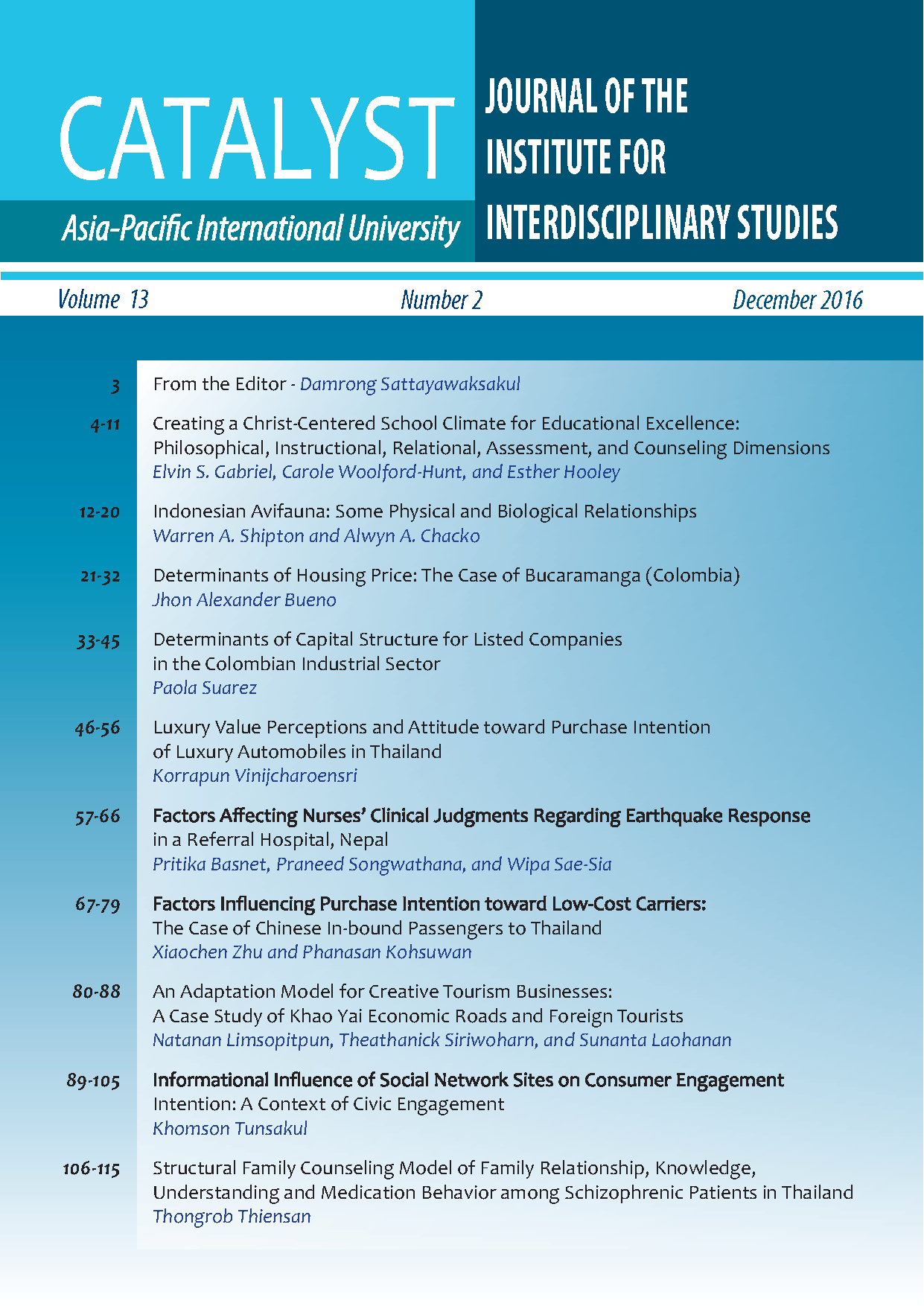An Adaptation Model for Creative Tourism Businesses: A Case Study of Khao Yai Economic Roads and Foreign Tourists
Main Article Content
Abstract
The objectives of this study were: 1) to investigate creative tourism activities that affected the adaptation of tourism businesses; 2) to study the opinions of foreign tourists towards creative tourism activities; and 3) to propose an adaptation model for creative tourism businesses along important roads near Khao Yai National Park, Thailand. The main approach used was quantitative; data collected from 390 foreign tourist respondents was analyzed using percentages, means, standard deviations, and multiple regression. This data was supplemented with interviews of 13 key entrepreneurs who operate nearby creative tourism businesses. The proposed model was reviewed and critiqued by experts during a seminar organized for all parties involved in this project. The results indicated that the 5 most important factors of tourists’ adaptation activities were learning, participation, networking, cooperation, and guidance. The tourists’ opinions regarding creative activities and adaptations were very favorable. The study revealed that the factors and activities that affected foreign tourists’ opinions of creative tourism businesses were: 1) sightseeing, 2) contemplating, 3) souvenir purchases, 4) learning, 5) participation, and 6) co-creation. The results showed that the model explained 71.40 percent (R2 = 0.714) of the variation at a statistically significant level of 0.05.
Article Details

This work is licensed under a Creative Commons Attribution-NonCommercial-NoDerivatives 4.0 International License.
Copyright: Asia-Pacific International University reserve exclusive rights to publish, reproduce and distribute the manuscript and all contents therein.
References
Boukas, N. (2008). Cultural Tourism, Young People and Destination Perception: A Case Study of Delphi, Greece. Doctor of Philosophy in Management Studies, University of Exeter.
Chowdhary N. and Prakash M. (2007). Prioritizing Service Quality Dimensions. Managing Service Quality: An International Journal, Vol 17 Issue 5, 493-509.
Cochran, W.G. (1953). Sampling Techniques. New York: John Wiley & Sons. Inc.
Kaewsanga P and Chamnongsri N. (2012). Creative Tourism: A New Choice of Thai Tourism. Suranaree journal of social science. Vol 6, No 1 July 2012, 93-111.
Naknat, I., Thonghor R., Angkoon, R., Santhat, S., Chiawwan, B., Sawnphoom, P., and Yuprasert, B. (2008). Tourism Networking by the Community Through Participatory Action Research in the Central Region. Ramkhamhaeng University.
Patarathammaporn, A. (2008). Factors Affecting to Decision to Route to Chiang Mai of Foreign Tourists. Independent Study Economics Faculty of Economics, Chiang Mai University.
Pine, B.J. II, and H.J. Gilmore. (1999). The Experience Economy: Work is Theatre and Every Business a Stage. Boston, MA: Harvard Business School Press.
Promburom T. and Kimpakorn N. (2015). Factors Affecting Tourist Experience of Eco, Culture, and Wellness Tourism in the Upper Northern Provincial Cluster 1 of Thailand: Chiang Mai, Lamphun, Lampang, Mae Hong Son. Journal of Thai Hospitality. Vol. 10, No 1 January-June 2015, 71-87.
Redl, S. (2013). Culinary Tourism for Young Adult Travelers and its Connection to Destination Management. Bachelor Thesis for Obtaining the Degree. Modul University Vienna, Austria.
Richards, G. (2010). Creative Tourism and Local Development. In Wurzburger et al., Creative Tourism: A Global Conversation: How to Provide Unique Creative Experiences for Travelers Worldwide, 78-90. Santa Fe: Sunstone Press.
Richards, G. (2011). Creative and Tourism: the State of the Art. Annals of Tourism Research, 38, 4, 1225-1253.
Tan, Siow-Kian; Kung, Shiann-Far; and Luh, Ding-Bang. (2014). A Taxonomy of Creative Tourists in Creative Tourism. Tourism Management National Cheng Kung University, Taiwan, ROC.
Vanichbuncha K. (2003). Statistical Analysis: Statistics for Management and Research (7th ed.): Company of Thammasarn.
Wisudthiluck S., Saiphan, P., Teplakul, O., Sindecharak, T. and Mokthaisong, A. (2012). Creative Tourism Model. Bangkok: Thammasat University. Full research reports submitted to the Designated Areas for Sustainable Tourism Administration (Public Organization).


